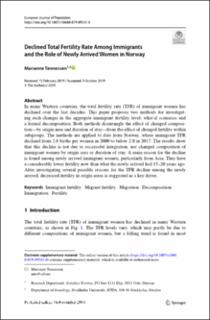| dc.contributor.author | Tønnessen, Marianne | |
| dc.coverage.spatial | Norway | en_US |
| dc.date.accessioned | 2020-02-14T15:05:50Z | |
| dc.date.available | 2020-02-14T15:05:50Z | |
| dc.date.created | 2019-11-08T18:18:38Z | |
| dc.date.issued | 2019 | |
| dc.identifier.citation | European Journal of Population, 2019, | en_US |
| dc.identifier.issn | 0168-6577 | |
| dc.identifier.uri | https://hdl.handle.net/11250/2641830 | |
| dc.description | This article is distributed under the terms of the Creative Commons Attribution 4.0 International License (http://creativecommons.org/licenses/by/4.0/), which permits unrestricted use, distribution, and reproduction in any medium, provided you give appropriate credit to the original author(s) and the source, provide a link to the Creative Commons license, and indicate if changes were made. | en_US |
| dc.description.abstract | In many Western countries, the total fertility rate (TFR) of immigrant women has declined over the last decades. This paper proposes two methods for investigating such changes in the aggregate immigrant fertility level: what-if scenarios and a formal decomposition. Both methods disentangle the efect of changed composition—by origin area and duration of stay—from the efect of changed fertility within subgroups. The methods are applied to data from Norway, where immigrant TFR declined from 2.6 births per women in 2000 to below 2.0 in 2017. The results show that this decline is not due to successful integration, nor changed composition of immigrant women by origin area or duration of stay. A main reason for the decline is found among newly arrived immigrant women, particularly from Asia. They have a considerably lower fertility now than what the newly arrived had 15–20 years ago. After investigating several possible reasons for the TFR decline among the newly arrived, decreased fertility in origin areas is suggested as a key driver. | en_US |
| dc.description.sponsorship | Open access funding provided by Stockholm University. Financial support from the Swedish Research Council (Vetenskapsrådet) via the Swedish Initiative for Research on Microdata in the Social and Medical Sciences (SIMSAM), Grant 340-2013-5164, as well as from the Swedish Research Council for Health, Working life and Welfare (FORTE), Grant 2018-00310. | en_US |
| dc.language.iso | eng | en_US |
| dc.publisher | Springer Nature. | en_US |
| dc.rights | Navngivelse-Ikkekommersiell 4.0 Internasjonal | * |
| dc.rights.uri | http://creativecommons.org/licenses/by-nc/4.0/deed.no | * |
| dc.subject | Innvandring | en_US |
| dc.subject | Immigration | en_US |
| dc.subject | Fertility | en_US |
| dc.subject | Immigrant fertility | en_US |
| dc.subject | Migrant fertility | en_US |
| dc.title | Declined Total Fertility Rate Among Immigrants and the Role of Newly Arrived Women in Norway | en_US |
| dc.type | Peer reviewed | en_US |
| dc.type | Journal article | en_US |
| dc.description.version | publishedVersion | en_US |
| dc.rights.holder | © The Author(s) 2019 | en_US |
| dc.subject.nsi | VDP::Samfunnsvitenskap: 200::Sosiologi: 220 | en_US |
| dc.subject.nsi | VDP::Samfunnsvitenskap: 200::Demografi: 300 | en_US |
| dc.source.journal | European Journal of Population | en_US |
| dc.identifier.doi | 10.1007/s10680-019-09541-0 | |
| dc.identifier.cristin | 1745538 | |
| cristin.unitcode | 5932,5,0,0 | |
| cristin.unitname | Forskningsavdelingen | |
| cristin.ispublished | true | |
| cristin.fulltext | original | |
| cristin.qualitycode | 1 | |

